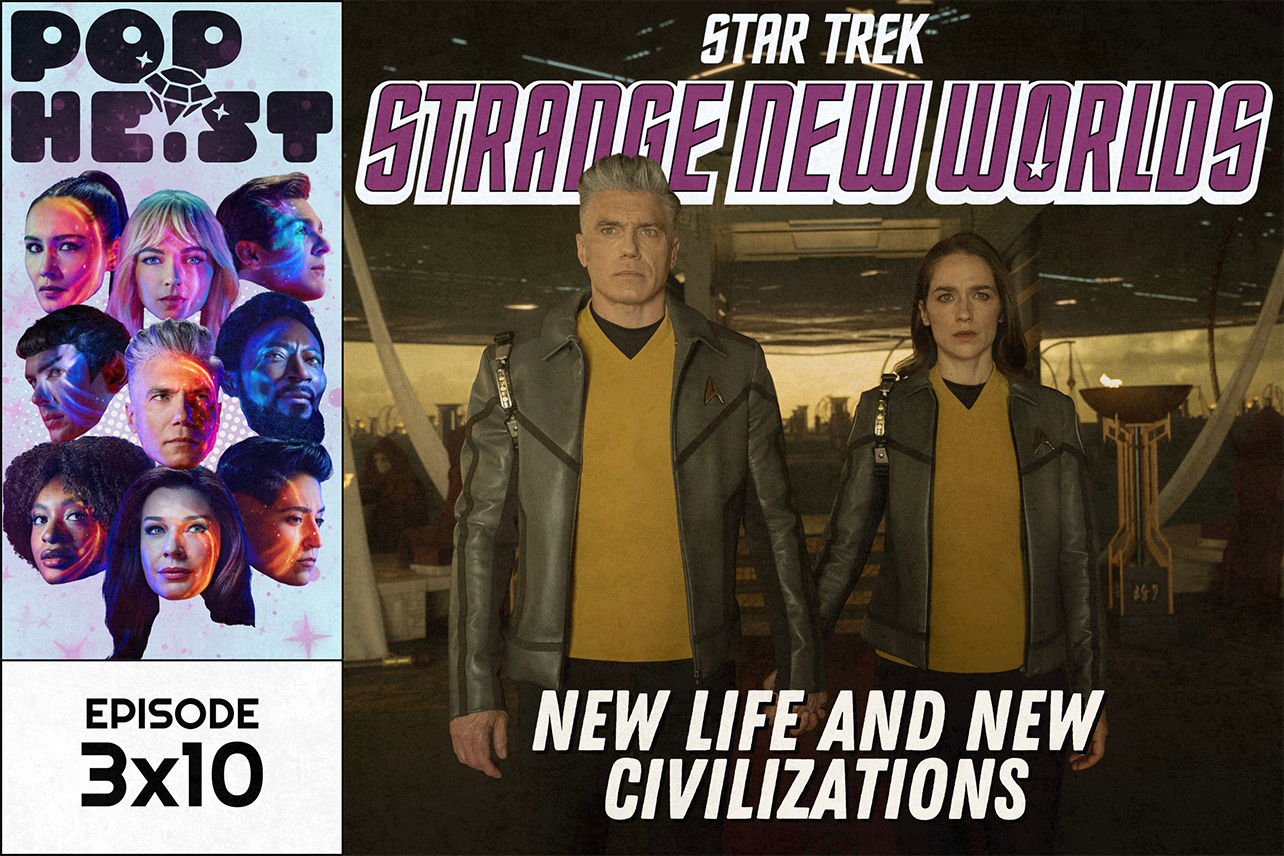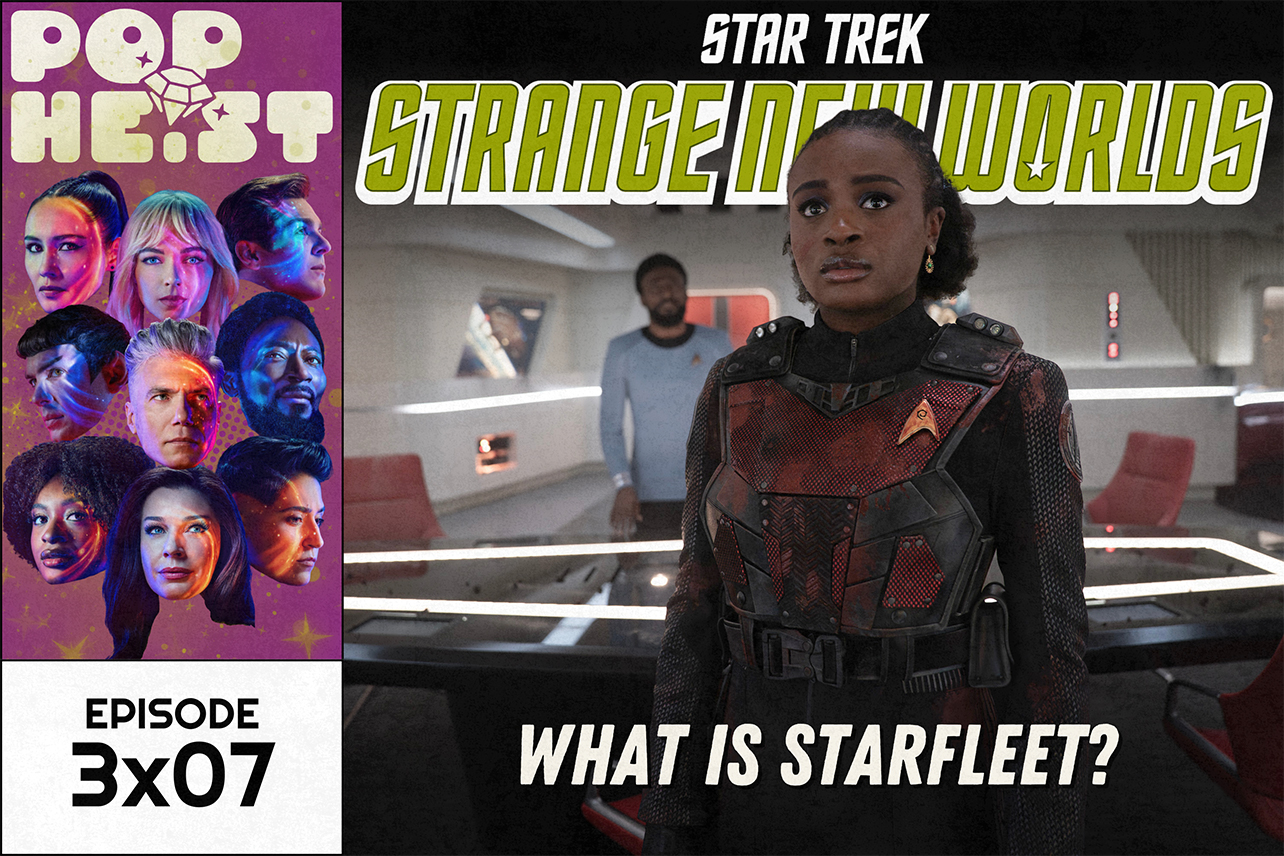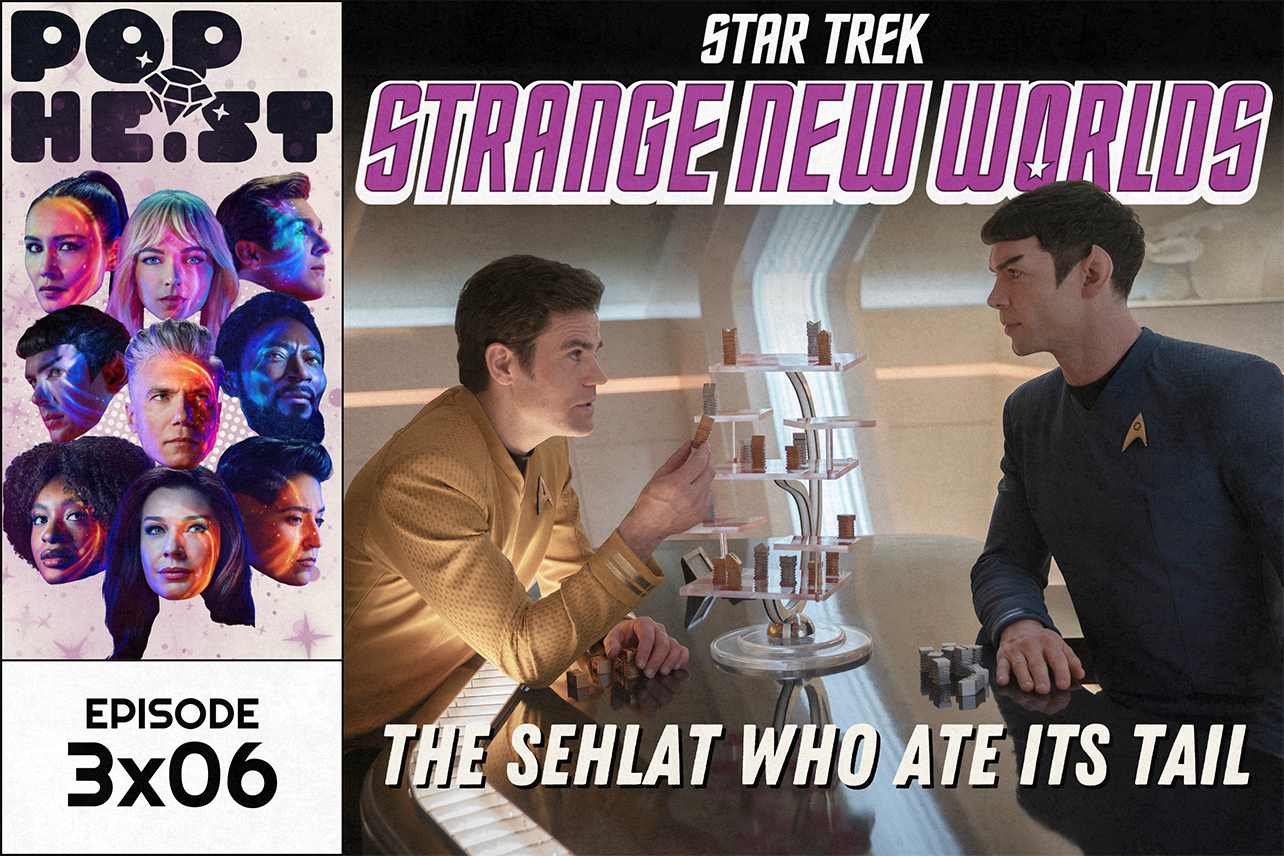This analysis is part of a short series from contributor Ally Roth, who will be unpacking the third season of Star Trek: Strange New Worlds and asking how, or indeed if, it's meeting the moment we're currently in. Check out our intro post here, and our recaps for Episode 1 and Episode 2.
Welcome back, Star Trek: Strange New Worlds! It has been many minutes since last we saw you. And relevant to this piece, the world has changed a lot since Season 2's finale, "Hegemony." We've got new wars. New genocides. An old president building new concentration camps. Also, I adopted a cat. So, you know: stuff is going on.
The big question is: how will the new season of Strange New Worlds fit into all of that? And straightaway, there's certainly opportunity with the conclusion to last season's battle with the Gorn to speak to the moment. But do things really line up? Let's take a look.
Looking back at where "Hegemony" starts, it's easy to see at least one obvious inroad for exploration. The first half of "Hegemony" focuses on the Gorn attacking a Federation colony only to set up a line of demarcation with the colonists' world on the Gorn side. The immediate need to save the colonists becomes complicated by the conflict between Captain Pike's desire to fight back and Starfleet's desire to keep the peace with the Gorn by honoring the line.
"Hegemony" ends with Pike having to choose between retreating or breaking from Starfleet directive and staying to fight. And the option is there with "Hegemony, Part II" to explore real-world conflicts. Russia and Ukraine. Israel and Palestine. But ultimately, we don't really get any of that with "Hegemony, Part II" — and that, on its own, is not a bad thing.
What "Part II" does is tell a story about strategy. More importantly, it tells a story about trying to be strategic without sacrificing hope. Pike has to leave half his crew on a Gorn ship, but he's able to track the ship while dealing with Starfleet. Strategy. Hope. Starfleet wants to maintain the line rather than antagonize the Gorn and ignite further hostilities. But they're willing to let Pike cautiously take a shot at fighting back on his own. Strategy. Hope.
And surreptitiously, if there is a trajectory for this season of Star Trek: Strange New Worlds, it is one of strategy regarding where we are all at now. This episode is a story that addresses this moment indirectly. Certainly "strategy and hope" very much aligns with our real world. There is no immediate way out of where we are. And there's no cavalry coming to save us. So it becomes about trying to figure out when to run, how to fight, what to sacrifice, and where to risk.
To be honest, I think if the creative team behind SNW tried to make "Hegemony, Part II" directly about struggling within one’s own political party to fight a dangerous opposition, it would feel both too on the nose and unearned within the story they've told so far. Yes, the ugly truth about the real world is that, right now, the political party holding power over the United States is way more like the Gorn than they are like the Federation. But that's not the first half of the story SNW was setting up a few years ago, so, pragmatically, the second half should conclude in a way that corresponds with the first.
The result is an episode that hits the moment incidentally rather than purposefully — and this yields mixed results.
The Enterprise takes on this mission to fight the Gorn, save their crew and the colonists, and somehow win a decisive victory against the Gorn. It's very "the only ones who are going to save us are ourselves"-coded, and that is entirely moment-meeting. What's more, our characters ultimately refuse to leave people behind. Pike wants his crew back, and he risks the ship and everyone on it to get them. La'an, meanwhile, on the Gorn ship, takes charge and makes the mission about saving every living colonist on board rather than solely opting to save the crew's skin.
And there are other analogs that address our reality along the way. The mainstream of Starfleet is not acting, and that means the minority, with their limited power, has to rise to the occasion. That's pretty fucking real!
Captain Batel's situation is especially pointed. She is infected with Gorn spawn and about to die. The only chance she has involves utilizing some of Una's Illyrian blood. Batel is the one who arrested Una way back in Season 1 and expected Una to accept losing her career simply for being Illyrian. There is something poetic about Batel's life being saved by the literal blood of someone who the Federation deems illegal for their very nature. If Una had done as Batel — give up her commission and abandon Starfleet — Una wouldn't have been on the Enterprise to save Batel's life. In other words, forcing people out of society for being who they are has a negative impact on everybody. Once again, that's fucking real as hell — and definitely speaks to our moment.
This is Star Trek performing its most famous maneuver: hope writ large with a healthy dose of personal responsibility. And the nice thing about this tried-and-true formula is that it adapts well both within the story and within our reality to the idea that "none of us is free until all of us are."
Where things fall apart is in the resolution of "Hegemony, Part II." The Enterprise crew figure out that the Gorn go into hibernation based on the appearance of certain lights in the sky. The episode ends with the crew using the ship's technology to imitate those lights, putting the Gorn to sleep for an unknown amount of time.
The people behind Star Trek: Strange New Worlds really want this show to connect with the continuity of Star Trek: The Original Series. In this case, that means the Gorn kind of have to lose. We're told that, prior to the Enterprise light show, the Gorn are basically set to invade and obliterate the Federation. But that's not what happens in TOS, so it can't be what happens in SNW. And that leaves us with a too-quick resolution. Not only is that narrative unsatisfying, but it fails to meet the moment.
The pieces are there. The strategy and hope aspect works. But this abrupt victory feels hollow. It's a choice between being discordant with continuity and being discordant with both the story being told and the real world moment it's being told in — and SNW chooses the latter.
Before we talk about "Wedding Bell Blues," there is one other moment from "Hegemony, Part II" that feels noteworthy. After the battle is over and the day is won, Pike goes down to sick bay to see how Batel is doing. In that moment, Pike does something we almost never see in Star Trek: He prays. Specifically, Pike begins to recite the Lord's Prayer.
Antisemitism and transphobia get demonstrably worse on a daily basis thanks in no small part due to the use of Christianity to justify fascism. Christianity may represent hope and community for some — Pike actor Anson Mount included — but in this moment, Christianity is very much being weaponized by the oppressor. This is not an indictment of Christianity as a whole; it is an acknowledgment of our reality — and why Pike saying the Lord's Prayer stings a little. It's also a blink-and-you'll-miss-it detail.
Frankly, if Star Trek wants to embark on this particular conversation, it can't be a throwaway. A world where Christianity plays nice with everything else is a great thing to hope for — yes, even in the Star Trek universe. In any other moment, I think Star Trek could investigate a way to weave human faith into its tapestry. But in this case, it feels both out of left field and at odds with our real-world circumstance.
Anyway! "Wedding Bell Blues" — the trickster-god episode where Spock has to fight his own desire to marry Christine Chapel in favor of honoring her wants and saving reality itself. It's Star Trek: Strange New Worlds doing one of the things it does best: being funny. But buried beneath the humor, there are a few things worth inspecting.
The first major point surrounds La'an Noonien-Singh. Since the outset of the series, La'an has always been extremely tense and buttoned up. The reason is pretty simple: She was captured by the Gorn as a child, was the sole survivor of that kidnapping, and has lived in a constant state of fear and preparedness hence.
But now the Gorn are in sleep mode, which leaves La'an with the question: Who am I without the monster under the bed? And the answer, thus far at least, is that she is a dancer. In fact, La'an is such a good dancer that she's able to teach Spock — while being very flirtatious in the process. Spock even notes that La'an seems "lighter" since the Gorn disappeared.
And the hopeful Star Trek message is pretty simple: There is room for joy, even after a lifetime of trauma. I wouldn't call it a direct message from Star Trek to this moment in particular, but it's certainly not an unwelcome one.
That said, the episode "Wedding Bell Blues" reminds me most of "Serene Squall." Both feature queer-coded characters teaching Spock a lesson. In "Serene Squall," Captain Angel intentionally teaches Spock about the beauty of living the identity you are instead of the one you are expected to be. And in "Wedding Bell Blues," Rhys Darby's character (who is probably Trelane from TOS) accidentally helps Spock learn to accept that his relationship with Chapel is over.
The complexity here is that both these characters are villains. Yes, they are helpful in a way, but they're also pretty evil!
There's an additional wrinkle with "Wedding Bell Blues." After the story resolves, there's a dance sequence. And I think there's a Star Trek record for how many couples wind up on the dance floor where at least one major character is in the pairing. In no particular order, we have: Pike and Batel, Chapel and Korby, Uhura and Ortegas's brother, and Spock and La'an.
Half the couples are dating, with the implication that the other half will date in the future. And without exception, every couple is heterosexual. We see some friendly same-sex dancing in the background, but nothing romantic.
Meanwhile, Ortegas, one of our only queer-coded heroes, has a very different ending for this story. During "Hegemony, Part II," Ortegas gets half her hand melted off, and is later impaled by a Gorn. At the close of "Wedding Bell Blues," she storms off to attack a punching bag only to reveal that she is so traumatized by her experience with the Gorn that she can picture one standing behind her menacingly.
Queer identity, despite the coding, is in short supply on Star Trek: Strange New Worlds. We know Chapel had something going with another woman once but that it was by accident. And in "Elysium Kingdom," an all-powerful–entity Ortegas and Una are a couple in a fictional world. It's not official, but that's as close as we get to exploring Ortegas's romantic connections.
So it's a complicated watch to see La'an, who we previously established is more free post-Gorn, dancing romantically with Spock while Ortegas sits it out, traumatized and unloved on the sidelines.
Unlike most of the other story elements we can link to today's reality, this is the only one that reads pessimistic. While unintentional, in its final moments, "Wedding Bell Blues" reminds us that some people may feel free, but many of us very much are not — queer people being a prime example. Ortegas's story is open right now. Only time will tell how it resolves and how that resolution addresses today's troubles.
Two episodes in and Star Trek: Strange New Worlds meets the moment with a mixture of hope and unease. Fitting.






